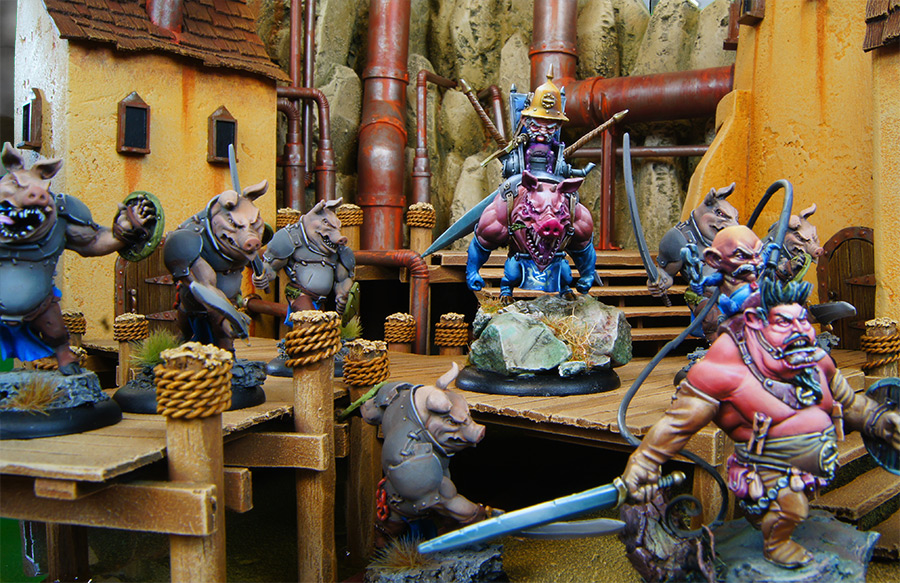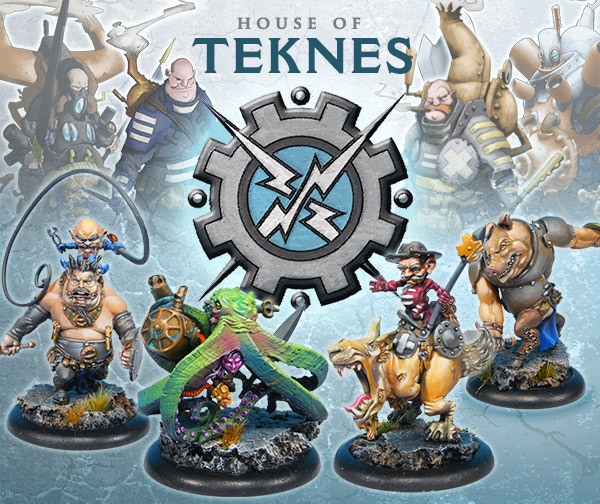Let me preface this by saying that Confrontation (Rackham – The Best Game Ever) is my favorite game from both an overall aesthetic and mechanical point of view. It managed to capture a feeling that both GW and PP games have failed at. The alternating activation works on so many levels, individual model activations combined with special abilities create interactions that often cannot be predicted. The combined close combat phase of that game was and remains pure genius. With all of that out of the way let’s talk Wrath of Kings and see why it almost scratches that itch.
Wrath of Kings is a new game, funded by kickstarter, and owned and released by CMON (Cool-Mini-Or-Not). The entire range has pretty creative from an aesthetic/sculpting perspective. Each of the five factions are well defined by their ranges. The concept art was done by Edouard Guiton who also did much of the concept art for Confrontation. The influence is felt and appreciated.
Models
The models themselves are plastic though much closer to the pvc style stuff PP uses rather than the nice clean polystyrene used by GW and Malifaux, amongst others. The pvc style stuff is workable but it’s not the most pleasant material. Shaving with a blade is your friend here rather than using a file. Assemble is keyed sockets so mostly idiot proof and there are just enough sculpts of each model type to not get too many repetitive models.Aesthetically the game adopts a fantasy steampunk light style that isn’t bad at all. The Teknes and Shael Han factions have more obvious steampunk elements while the Nassier and Goritsi have almost none. Goritsi show a similarity to the old Rackham Wolfen and Devourer models. Nassier have their own unique vibe. Hadross has a very unique under-the-sea look crossed with just a hint of Cthulu mythos while Shael Han are very eastern/oni.
Each faction has three subfactions with in it. For instance Goritsi have the Wolfen, Vampire, and Ravenscar Mercenaries. All three play well together but you could theoretically field all Wolfen (and I do…). Shael Han have Legionairres, Wraths (Oni), and the Lotus Dancers (assassins) and so on throughout the factions. This allows you to play a combine army or unique sub-factions within a given army.
Force Selection
Games are played in three sizes, Intro, Skirmish, and Battle. The Intro game fields are 8-16 models. Forces are selected based on rank. Rank 1 = 1 point, Rank 2 = 2 points per model and each game size indicates how many ranks of a given model type you are permitted.There are three basic model types, Leaders, Specials, and Infantry. In the Intro game you are permitted:
2 Ranks of Leaders
2 Ranks of Specials
12 Ranks of Infantry.
A Rank 2 model = 2 ranks. So for my Shael Han for the Intro level game I field:
Leader - The Warchild (Rank 2)
Special – Fu Lung Dragon (Rank 2)
Infantry – 6 Wraths (Rank 2)
This basic model extends to all of the game sizes.
Gameplay
Basic gameplay in Wrath of Kings consists of alternating activations of between 1 or more models. Specialist models always activate as single activation but the leader(s) can order multiple models to activate at a time. The game size determines the number of models that can be activated in one go by a leader. Your army leader can always activate more models than a regular leader.An activation consists of Movement and Action in any order. All movement in an activation must be done at the same time. All actions in an activation must be done at the same time. The models can move wherever they want or perform whatever action they want but they must all be done together.
Models can perform combined attacks or individual attacks, interact with the environment, take additional movement (in the form of the Sprint action) or perform anything on their card that counts as an action.
Determining victory is based on Morale. Each player has a number of Moral points based on the size (number) of models in their army. You get one Morale for each rank of leader and one for every three models at the beginning of the game. Morale points are not replenished at all (thus far). A player loses morale as a result of causalities (in the same manner they are generated) and as a result of Motivations (which are the scenarios for the game).
Motivations (scenarios) are based on faction and each player has access to up to 6 options to choose from. Each player chooses their own and reveals to their opponent. Motivation completion requirements vary from one to another however all result in additional lost Morale points for your opponent. Motivations can really swing a game at the Intro game size or so our experience shows.
Wrath of Kings is played on a 4x4 table with 2-3 pieces of terrain per player spread around the table. Terrain has minimal impact on the game as there is no concept of cover. Line of sight is based on model/terrain feature size. Terrain can be declared to have certain properties, most commonly Rough [x] where [x] represents an additional number of inches of movement that must be sacrificed to move into and out of.
Basic Mechanics
Wrath of Kings utilizes ten-sided dice. A model rolls a number of dice determined by his stats, abilities, and actions. A basic attack action utilizes the models melee attack (they are all different) and compares the result of the die roll against the defender defense chart, which is printed on the card. The defense chart is labeled 1-10 and each number has a symbol attached to it, block, parry, dodge, armor, magic, strike, and overpower. There are abilities in the game that are triggered by the die roll result. For instance the Sundering ability turns the first armor result on the chart (from top to bottom) into an additional strike, while Suppression does the same for magic results.Model defense charts are mostly unique with factions and model types have much in common. Shael Han for instance have many magic and parry results on their chart while Hadross has magic and armor commonly. Any die roll that results in a strike normally results in damage, though not always.
There are four basic kinds of attacks, melee, ranged, magic and will. It should be noted that the longest range attack we have seen in the game thus far is 9” with that being variable based a number of successes at a will test. Six to eight inches are fairly common range increments, and there really is not a lot of range in the game right now.
Impressions
So my overall impressions of the game are quite favorable. The smaller scale (we have only played Intro and demo (1/2 of the Intro size on a 2x4 table) enables us to play fast games. The basic rules are very light but the interactions between the models are quite deep as you look for ways your die rolls interact with the defender’s defense chart.Factions are well defined in both aesthetic and mechanically. Each faction looks like it has the tools to beat any other but there will be bad match ups, typically based on how you can manipulate the chart in your favor.
The rules themselves has some editing issues, and a few vague spots. It can be easy to read more into the rules than is actually there, especially if you play a lot of games are really ‘into’ reading rules. The rules is permissive, meaning the rules describe what a model CAN do, not what they cannot.
The game is priced very competitively with the basic starter boxes for each faction retailing at ~$70.00 and those boxes containing everything one needs to play a full intro sized game. The retail model is pretty interesting once you get past the starter box. You have the option to buy more infantry boxes, specialist boxes (by rank) and character boxes. Again these boxes are priced very fairly for the current market place.
Oh and the rules are free.
Questions going forward
One of your biggest questions going forward is continued support and form that support will take. CMON has said they want a release model similar to their Dark Age game, which is roughly a new book every six months with model support. Rumor has it the next book will be in Feb of 2016 with a campaign book to possibly follow in the same year. If so that’s great but waiting for eight months for new releases is going to make building momentum for a community difficult. New models simply drive interest.Another question I have regarding continued support really revolves around how CMON is planning to fund further support. I do not want to be on a perpetual Kickstarter support train. It’s one thing for a small studio to use KS to fund,(see Guildball, Kingdom Death, and Arena Rex for positive examples) quite another in my mind for one of the industry players to continually use that model to essentially pre-sell merchandise.
Finally FAQ support is present but like most games could be better, and I wonder if they are committed to balancing the game on the fly if necessary. Not having played larger games I am withholding judgement but at smaller games sizes we are seeing some possible issues with Hadross. Their ability to essentially Resonate at will (it’s complicated the rules are free, go look at it) is causing all kinds of fits, combined with their basic models being hit on an eight or better, make overcoming them very difficult. Again withholding final judgement until we get more games and at a larger point level in but it is an issue I am watching closely.
Conclusions
I started this post talking about Confrontation and why this game almost scratches that itch. The game scale, even up to skirmish level is comparable. Alternating activation and deep interactions between models keeps me engaged for the whole game, as opposed to say Warmachine where most of what I do in your turn is simply pick up models. Even GW’s games allow me some interaction through the combined CC phase and the simple fact I get to make saves. That sense of engagement combined with the speed at which the game plays and resolves means I can play multiple games on a game night not feel drained afterwards. I am challenged by the interactions and by the tactics on a turn by turn basis.While all of these things exclusive to Confrontation or Wrath of Kings, or any other game for that matter, and the core mechanics are very different, I feel the same when I play this game as when I played Confrontation. For someone who has been chasing that feeling for several years now that’s definitely a great thing.
I encourage you to give the game a try. It’s cheap, fun, and very playable.









3 comments:
Really enjoying this game.
Thanks for stopping by. I agree. I am enjoying this game quite a bit. I was part of the playtest and if you had asked me when it ended if I was going to play it, the answer would have been no.
A few friends and myself are just about done painting our forces, and will be trying out the game shorty. Very excited to get started!
Thanks for sharing your thoughts, I enjoyed the read!
Post a Comment